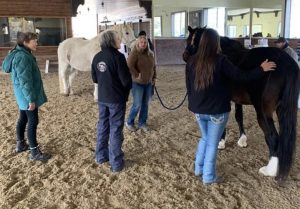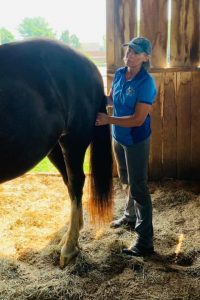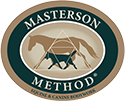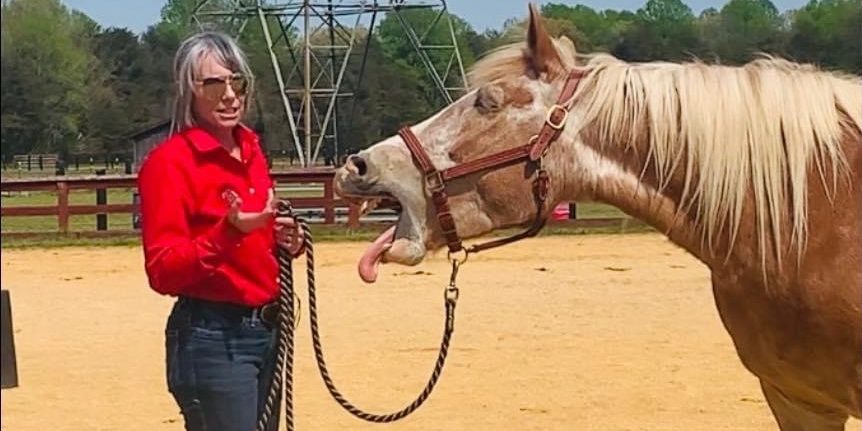by Alice Long
The Masterson Method® Integrated Equine Performance Bodywork offers various courses that range from two to five days. To add to that, numerous Masterson Method® Certified Practitioners (MMCP) also offer Interactive Demonstrations for anyone who is interested in learning a little more about this method of bodywork, as well as a few key techniques that anyone can do! These demos usually take just two to three hours.
What can you expect when you attend an Interactive Demonstration? You will learn the history of how The Masterson Method® was created, which is an interesting story on its own. You will also learn about how, as a prey animal, horses respond to humans and how to work beneath the fight, flight, or freeze response (brace response) while using this method of bodywork. As a prey animal, a horse’s natural instinct is to “brace” against just about everything they encounter, both physically and mentally.
 You will learn about some of the principles of The Masterson Method®, such as the various levels of pressure, which relate to the food we all enjoy: eggs, grapes, lemons, and limes. These levels of touch and how we use them are key in staying under the horse’s “brace” response. You will practice adjusting your touch, as many times we are never soft enough.
You will learn about some of the principles of The Masterson Method®, such as the various levels of pressure, which relate to the food we all enjoy: eggs, grapes, lemons, and limes. These levels of touch and how we use them are key in staying under the horse’s “brace” response. You will practice adjusting your touch, as many times we are never soft enough.
Maybe you’ve heard of “search, response, stay, release – SRSR”. This is one of the most important and effective principles we use when offering The Masterson Method® to the horse that you will get to practice. We will explain the horse’s responses to our touch and how to adjust ourselves to help the horse release tension in the body. When the horse releases tension, he shows us in several ways – and we’ll discuss those as well.
There are numerous reasons why horses need bodywork, which we refer to as “indications”. These are discussed at the demo and you’ll have an opportunity to discuss your horse’s signs or behaviors, and what those might mean. “Contraindications” or when not to do equine bodywork will also be discussed.
You will learn three light-touch techniques that will provide instant results with the horses at the demo. Then you can take those techniques home to try with your own horse.
The first technique you will learn is called “The Bladder Meridian” technique. It allows the horse to release deep, accumulated pain and tension in muscles and connective tissues of the entire body. It is also known to help the horse go into a deep, relaxed state, as we tap into the parasympathetic nervous system – “rest and digest”. The Bladder Meridian technique is a great way to introduce yourself to a horse and learn their responses to your touch. This opens the lines of communication so that the horse knows you are on the same page and are listening to them. It creates a wonderful partnership between horse and human!
The second technique you will learn is “TMJ Points”. The TMJ (temporomandibular joint) of the horse is what we refer to as “the nerve highway”. Muscles and connective tissues surrounding this joint can negatively affect your horse.
One of the signs that your horse may have tension in the TMJ is that he may get a headache (sore poll). Many horses will go behind the bit to take the pressure off the TMJ, exhibit a shortened stride, drop feed, have a stiff neck and less range of motion in lateral movements, become head shy, may be reluctant to accept the bit, and have a general imbalance of the entire body. With this light touch technique, you can help your horse release tension in the TMJ resulting in improved behavior and performance.
 The third technique is a really fun one! Even the name is fun . . . “Sacrum Float”! When Jim Masterson was asked if he could use only one technique of The Masterson Method®, his answer, as you can certainly guess, was Sacrum Float. This technique is super powerful and watching the horse’s responses and releases to this one is as fun as the name.
The third technique is a really fun one! Even the name is fun . . . “Sacrum Float”! When Jim Masterson was asked if he could use only one technique of The Masterson Method®, his answer, as you can certainly guess, was Sacrum Float. This technique is super powerful and watching the horse’s responses and releases to this one is as fun as the name.
When the muscles of the horse’s hind end grow tight, it can create tension that may pull on the sacrum and put torque on the sacroiliac joint. You may notice that your horse’s tail is clamped down, they may lack impulsion, one hind leg may have a shorter stride than the other, they may buck, be reluctant to shift weight to the hind end lead, or have lead change difficulty. The Sacrum Float can help improve all of these things, and if that’s not enough, this technique can also release tension in the horse’s back, neck, and poll.
Nearing the end of the demo and practice time with horses, we regroup so that participants have time to ask questions pertaining to the work they completed with the horses and address anything else about the demo, as well as what is offered to your horse during a full bodywork session. We discuss in more detail the various courses offered by The Masterson Method® as well.
Some MMCPs set up a demo table where you can purchase Masterson Method® books, DVDs, and hats, as well as brochures and other information pertaining to the work. Attending or hosting a demo can be a great way to have fun with your fellow barn mates, boarders, trainers, farriers, and groups, and can even be customized for children all while helping the horse. Some MMCPs offer a free spot for hosts to attend!
Our hands alone are a powerful tool in helping horses release tension in their body. Be sure to find an interactive demo in your area so that you can begin utilizing these techniques in the most effective way possible so that you can help your horse feel better and build a deeper bond and understanding with you!
Join us at an expo or demo to see practical Masterson Method® techniques that you can bring home and use on your horses. Check your local area for a Masterson Method® demonstration by one of our Certified Practitioners. You will find information about future expos and demos at the following link: https://mastersonmethod.com/expos-demos/

